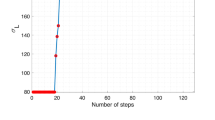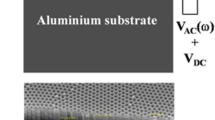Abstract
Recent advances in non-equilibrium statistical mechanics and single-molecule measurements have enabled the determination of equilibrium free energies from non-equilibrium work measurements for fluctuating systems ranging from biological molecules to quantum oscillators. However, for many important non-equilibrium processes, it is difficult or impossible to apply and measure the work required to drive the system through the relevant conformational changes. Here, we show that it is possible, with an appropriate extrapolation to infinite temporal scale and zero spatial scale, to determine equilibrium free energies, without work measurement, by analysing the stochastic trajectories of single biomolecules or other nanoscale, fluctuating systems as they spontaneously relax from a non-equilibrium initial state. We validate the method with simulations and demonstrate its application by determining the free-energy profile for DNA molecules in a structured nanofluidic environment with an experimental protocol that mimics many natural processes with energy injection followed by thermal relaxation.
This is a preview of subscription content, access via your institution
Access options
Access Nature and 54 other Nature Portfolio journals
Get Nature+, our best-value online-access subscription
$29.99 / 30 days
cancel any time
Subscribe to this journal
Receive 12 print issues and online access
$209.00 per year
only $17.42 per issue
Buy this article
- Purchase on Springer Link
- Instant access to full article PDF
Prices may be subject to local taxes which are calculated during checkout





Similar content being viewed by others
References
Jarzynski, C. Nonequilibrium equality for free energy differences. Phys. Rev. Lett. 78, 2690–2693 (1997).
Crooks, G. E. Entropy production fluctuation theorem and the nonequilibrium work relation for free energy differences. Phys. Rev. E 60, 2721–2726 (1999).
Hummer, G. & Szabo, A. Free energy reconstruction from nonequilibrium single-molecule pulling experiments. Proc. Natl Acad. Sci. USA 98, 3658–3661 (2001).
Liphardt, J., Dumont, S., Smith, S. B., Tinoco, I. & Bustamante, C. Equilibrium information from nonequilibrium measurements in an experimental test of Jarzynski’s equality. Science 296, 1832–1835 (2002).
Collin, D. et al. Verification of the Crooks fluctuation theorem and recovery of RNA folding free energies. Nature 437, 231–234 (2005).
Harris, N. C., Song, Y. & Kiang, C. H. Experimental free energy surface reconstruction from single-molecule force spectroscopy using Jarzynski’s equality. Phys. Rev. Lett. 99, 068101 (2007).
Shank, E. A., Cecconi, C., Dill, J. W., Marqusee, S. & Bustamante, C. The folding cooperativity of a protein is controlled by its chain topology. Nature 465, 637–640 (2010).
Gupta, A. N. et al. Experimental validation of free-energy-landscape reconstruction from non-equilibrium single-molecule force spectroscopy measurements. Nat. Phys. 7, 631–634 (2011).
Alemany, A., Mossa, A., Junier, I. & Ritort, F. Experimental free-energy measurements of kinetic molecular states using fluctuation theorems. Nat. Phys. 8, 688–694 (2012).
Saira, O. P. et al. Test of the Jarzynski and Crooks fluctuation relations in an electronic system. Phys. Rev. Lett. 109, 180601 (2012).
An, S. M. et al. Experimental test of the quantum Jarzynski equality with a trapped-ion system. Nat. Phys. 11, 193–199 (2015).
Jarzynski, C. Equalities and Inequalities: Irreversibility and the second law of thermodynamics at the nanoscale. Annu. Rev. Condens. Matter Phys. 2, 329–351 (2011).
Dufrene, Y. F. et al. Five challenges to bringing single-molecule force spectroscopy into living cells. Nat. Methods 8, 123–127 (2011).
Kopelevich, D. I., Panagiotopoulos, A. Z. & Kevrekidis, I. G. Coarse-grained kinetic computations for rare events: Application to micelle formation. J. Chem. Phys. 122, 044908 (2005).
Hayashi, K., Ueno, H., Iino, R. & Noji, H. Fluctuation theorem applied to F-1-ATPase. Phys. Rev. Lett. 104, 218103 (2010).
Beltran-Villegas, D. J., Sehgal, R. M., Maroudas, D., Ford, D. M. & Bevan, M. A. A Smoluchowski model of crystallization dynamics of small colloidal clusters. J. Chem. Phys. 135, 154506 (2011).
Edwards, T. D., Yang, Y. G., Beltran-Villegas, D. J. & Bevan, M. A. Colloidal crystal grain boundary formation and motion. Sci. Rep. 4, 6132 (2014).
Prinz, J. H. et al. Markov models of molecular kinetics: Generation and validation. J. Chem. Phys. 134, 174105 (2011).
Adib, A. B. Free energy surfaces from nonequilibrium processes without work measurement. J. Chem. Phys. 124, 144111 (2006).
Adib, A. B. Symmetry relations in chemical kinetics arising from microscopic reversibility. Phys. Rev. Lett. 96, 028307 (2006).
Hummer, G. & Kevrekidis, I. G. Coarse molecular dynamics of a peptide fragment: Free energy, kinetics, and long-time dynamics computations. J. Chem. Phys. 118, 10762–10773 (2003).
Sriraman, S., Kevrekidis, L. G. & Hummer, G. Coarse master equation from Bayesian analysis of replica molecular dynamics simulations. J. Phys. Chem. B 109, 6479–6484 (2005).
Hummer, G. Position-dependent diffusion coefficients and free energies from Bayesian analysis of equilibrium and replica molecular dynamics simulations. New J. Phys. 7, 34 (2005).
Gear, C. W., Kaper, T. J., Kevrekidis, I. G. & Zagaris, A. Projecting to a slow manifold: Singularly perturbed systems and legacy codes. SIAM J. Appl. Dyn. Syst. 4, 711–732 (2005).
Constable, G. W. A., McKane, A. J. & Rogers, T. Stochastic dynamics on slow manifolds. J. Phys. A 46, 295002 (2013).
Neupane, K., Manuel, A. P. & Woodside, M. T. Protein folding trajectories can be described quantitatively by one-dimensional diffusion over measured energy landscapes. Nat. Phys. 12, 700–703 (2016).
Zheng, W. W. & Best, R. B. Reduction of all-atom protein folding dynamics to one-dimensional diffusion. J. Phys. Chem. B 119, 15247–15255 (2015).
Best, R. B. & Hummer, G. Coordinate-dependent diffusion in protein folding. Proc. Natl Acad. Sci. USA 107, 1088–1093 (2010).
Socci, N. D., Onuchic, J. N. & Wolynes, P. G. Diffusive dynamics of the reaction coordinate for protein folding funnels. J. Chem. Phys. 104, 5860–5868 (1996).
Best, R. B. & Hummer, G. Diffusive model of protein folding dynamics with Kramers turnover in rate. Phys. Rev. Lett. 96, 228104 (2006).
Beltran-Villegas, D. J., Sehgal, R. M., Maroudas, D., Ford, D. M. & Bevan, M. A. Colloidal cluster crystallization dynamics. J. Chem. Phys. 137, 134901 (2012).
Sisan, D. R., Halter, M., Hubbard, J. B. & Plant, A. L. Predicting rates of cell state change caused by stochastic fluctuations using a data-driven landscape model. Proc. Natl Acad. Sci. USA 109, 19262–19267 (2012).
Stephens, G. J., de Mesquita, M. B., Ryu, W. S. & Bialek, W. Emergence of long timescales and stereotyped behaviors in Caenorhabditis elegans. Proc. Natl Acad. Sci. USA 108, 7286–7289 (2011).
Stephens, G. J., Johnson-Kerner, B., Bialek, W. & Ryu, W. S. Dimensionality and dynamics in the behavior of C. elegans. PLoS Comput. Biol. 4, e1000028 (2008).
Diaconis, P. & Rolles, S. W. W. Bayesian analysis for reversible Markov chains. Ann. Stat. 34, 1270–1292 (2006).
Bacallado, S., Chodera, J. D. & Pande, V. Bayesian comparison of Markov models of molecular dynamics with detailed balance constraint. J. Chem. Phys. 131, 045106 (2009).
Siettos, C. I., Graham, M. D. & Kevrekidis, I. G. Coarse Brownian dynamics for nematic liquid crystals: Bifurcation, projective integration, and control via stochastic simulation. J. Chem. Phys. 118, 10149–10156 (2003).
Chodera, J. D. & Pande, V. S. Splitting probabilities as a test of reaction coordinate choice in single-molecule experiments. Phys. Rev. Lett. 107, 098102 (2011).
Stavis, S. M., Geist, J., Gaitan, M., Locascio, L. E. & Strychalski, E. A. DNA molecules descending a nanofluidic staircase by entropophoresis. Lab Chip 12, 1174–1182 (2012).
Strychalski, E. A., Geist, J., Gaitan, M., Locascio, L. E. & Stavis, S. M. Quantitative measurements of the size scaling of linear and circular DNA in nanofluidic slitlike confinement. Macromolecules 45, 1602–1611 (2012).
Leith, J. S. et al. Free energy of a polymer in slit-like confinement from the Odijk regime to the bulk. Macromolecules 49, 9266–9271 (2016).
Chen, J. Z. Y. & Sullivan, D. E. Free energy of a wormlike polymer chain confined in a slit: Crossover between two scaling regimes. Macromolecules 39, 7769–7773 (2006).
Gore, J., Ritort, F. & Bustamante, C. Bias and error in estimates of equilibrium free-energy differences from nonequilibrium measurements. Proc. Natl Acad. Sci. USA 100, 12564–12569 (2003).
Palassini, M. & Ritort, F. Improving free-energy estimates from unidirectional work measurements: Theory and experiment. Phys. Rev. Lett. 107, 060601 (2011).
Doob, J. L. The Brownian movement and stochastic equations. Ann. Math. 43, 351–369 (1942).
Carpenter, B. et al. Stan: A probabilistic programming language. J. Stat. Softw. 76, 1–29 (2017).
Stan Development Team Stan Modeling Language User’s Guide and Reference Manual, Version 2.11.0; http://mc-stan.org/ (2016).
Stan Development Team RStan: the R interface to Stan, Version 2.10.1; http://mc-stan.org/ (2016).
Grassia, P. S., Hinch, E. J. & Nitsche, L. C. Computer simulations of Brownian motion of complex systems. J. Fluid Mech. 282, 373–403 (1995).
Tang, J. et al. Revisiting the conformation and dynamics of DNA in slitlike confinement. Macromolecules 43, 7368–7377 (2010).
Stavis, S. M., Strychalski, E. A. & Gaitan, M. Nanofluidic structures with complex three-dimensional surfaces. Nanotechnology 20, 165302 (2009).
Strychalski, E. A., Levy, S. L. & Craighead, H. G. Diffusion of DNA in nanoslits. Macromolecules 41, 7716–7721 (2008).
Acknowledgements
We thank M. Zwolak and J. Hubbard for careful reading of the manuscript and helpful comments.
Author information
Authors and Affiliations
Contributions
D.R. performed the simulations. D.R., E.A.S. and S.M.S. wrote the manuscript. D.R., E.A.S. and S.M.S. analysed the data. D.R. and C.J. developed the theoretical and statistical approaches. All authors discussed the results and commented on the manuscript at all stages.
Corresponding authors
Ethics declarations
Competing interests
The authors declare no competing interests.
Additional information
Publisher’s note: Springer Nature remains neutral with regard to jurisdictional claims in published maps and institutional affiliations.
Supplementary information
Supplementary Information
Supplementary Information, Supplementary Figures 1–16, Supplementary Table 1, Supplementary References 1–32
Supplementary Movie 1
Supplementary Movie 1 shows a longer sequence of the motion of the same two molecules that are shown in Fig. 4b of the main text. The molecule on the top right moves primarily forward (left to right) into regions of lower free energy. The molecule on the bottom left moves backward two steps before moving forward. The thin vertical lines show the position of step edges. The lateral distance between step edges is 4 µm. The time step between frames of the movie is 5 s.
Rights and permissions
About this article
Cite this article
Ross, D., Strychalski, E.A., Jarzynski, C. et al. Equilibrium free energies from non-equilibrium trajectories with relaxation fluctuation spectroscopy. Nature Phys 14, 842–847 (2018). https://doi.org/10.1038/s41567-018-0153-5
Received:
Accepted:
Published:
Issue Date:
DOI: https://doi.org/10.1038/s41567-018-0153-5



